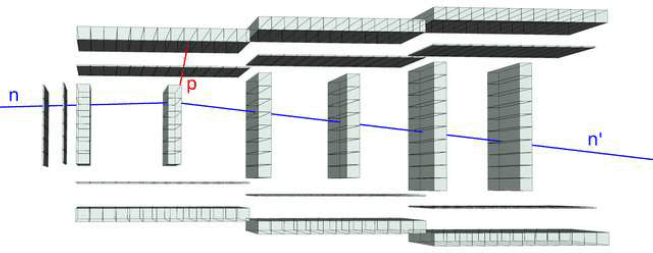Main Page
Welcome to C-GEN (E12-11-009) Wiki
Physics Documentation
Summary
The Neutron Electric Form Factor at Q2 up to 7 (GeV/c)2 from the Reaction 2H(e,e′n)1H via Recoil Polarimetry
We propose to extend our previous measurements of GnE from deuterium to Q2 = 6.88 (GeV/c)2 . Additional measurements at 5.22 and 3.95 (GeV/c)2 will provide continuity with our prior measurements up to Q2 = 1.45 (GeV/c)2 , and overlap with recent measurements from a polarized 3He target.
The JLab E93-038 collaboration measured GnE from the d(e, e′ n)p reaction on a liquid deuterium target at Q2 values of 0.45, 1.13, and 1.45 (GeV/c)2 . The experiment used a high-luminosity neutron polarimeter and the dipole neutron-spin-precession magnet [Charybdis] to measure the ratio of two scattering asymmetries associated with positive and negative precessions of the neutron polarization vector. In this ratio technique, systematic uncertainties are extremely small because the analyzing power of the polarimeter cancels in the ratio, and sensitivity to the beam polarization is reduced because it depends only on the small drift in polarization between sequential measurements. Use of a deuteron target yields a better separation between quasielastic and inelastic events, as well as a smaller proton background which must be cleanly separated from the neutron scattering events. Finally, the reaction mechanism and nuclear physics corrections [for FSI, MEC, and IC] are best understood and can be most reliably corrected for in the deuteron. The combination of these advantages is what yields 2–3% systematic uncertainties for the recoil polarization measurement, while the polarized 3He measurements typically have ≈10% systematic uncertainties.
The primary motivation for this proposed experiment is the ability to measure a fundamental quantity of the neutron -- one of the basic building blocks of matter. A successful model of confinement must be able to predict both neutron and proton electromagnetic form factors simultaneously. The neutron electric form factor is especially sensitive to the nucleon wave function, and differences between model predictions for GnE tend to increase rapidly with Q2 . Calculations and fits to the data up to 1.45 (GeV/c)2 show significant quantitative differences in the few (GeV/c)2 range, and make qualitatively different predictions for the behavior of GnE at higher Q2 values, with some showing GnE falling off more slowly than GnE, and others showing GnE falling rapidly to zero and becoming negative. The proposed measurements of GnE will be able to challenge theoretical calculations, including both models and new rigorous lattice QCD calculations, with a focus on the high Q2 range where the models of the nucleon are generally meant to be more complete. Finally, these measurements of GnE are also needed to understand electron scattering experiments that probe electric structure functions at high Q2, and will be important for the analysis of precision few-body data from measurements at Jefferson Lab.
PAC Documents
PAC 49 Jeopardy Review
- Submission to PAC File:E12-11-009 PAC49 Jeopardy Doc-Revised 04Jul2021.pdf
- Presentation: File:E12-11-009 PAC49-Jeopardy-Sawatzky-v2.pdf
- PAC49 Final Report: File:PAC49 FINAL Report.pdf
PAC 37
- Proposal (PAC37): File:PR-11-009.pdf
- TAC report (PAC37): File:TAC-PR12-11-009.pdf
- PAC37 Final Report: File:PAC37 Report.pdf
PAC 34
- Proposal (PAC34): File:PR12-09-006-PAC34.pdf
Earlier Experiments
JLab E93-038 (Hall C)
- Phys Rev C 73 025205 (2006): File:PhysRevC.73.025205.pdf
- Nucl. Phys A 764 (2006) 261--273: File:NuclPhysA 2006.pdf
Others
- Phys Rev Lett 92 042301 (2004): File:Warren PRL92 2004 042301.pdf
- Phys Rev Lett 87 081801 (2001): File:Zhu PRL87 2001 081801.pdf
Collaboration Membership
The C-GEN Collaboration is listed below. If you see an error or wish to join the Collaboration, please contact [Brad Sawatzky] or any other C-GEN spokesperson.
Spokespeople
- J. Arrington (ANL)
- M. Kohl (Hampton U.)
- B. Sawatzky (JLab)
- A. Semenov (U. Regina)
Contact Person: [Brad Sawatzky]
Experiment Coordinators
Collaboration Council
Mailing List
Collaboration Membership
Charter
- Charter (Final) : File:C-GEN charter-14Nov2014.pdf (Formally adopted as of 13 February 2015.)
Meetings
Collaboration Meetings
Hardware
Magnet Documentation
Polarimeter Documentation
C-GEN Polarimeter Documentation
Software
Simulation Codes
The collaboration has work space at /work/hallc/c-gen/ (accessible on the ifarm machines). Contact Brad Sawatzky <mailto:brads@jlab.org> for write access.
Using the JLab Farm
- Quick Start page here: https://scicomp.jlab.org/docs/getting_started
- Environment setup information for ROOT/G4 etc is here: https://data.jlab.org/
- Basically, run a few short test jobs on an interactive node (ie. ifarm65.jlab.org) just as you would on your desktop.
- Source code and binaries can reside in your /home directory. (If space is an issue, let me know.)
- Large output (*.root) files must be written to
/volatile/hallc/cgen/<your_jlab_username>/- Note the delete policy for the /volatile file system here: https://scicomp.jlab.org/docs/volatile_disk_pool
- Basically, if it's something that we want for long term, then you must push it to tape and access it through the /cache filesystem.)
- Once the code is working, then generate a control script for a batch job and submit it using 'jsub': https://scicomp.jlab.org/docs/jsub
- There are a number of examples here: https://scicomp.jlab.org/docs/auger_examples
- A few parameters you'll need are:
PROJECT : cgen TRACK : simulation OS : centos65
- Note the best practices / FAQ here: https://scicomp.jlab.org/docs/batch_job_faq
- Watch jobs in the queue here: http://scicomp.jlab.org/scicomp/#/auger/jobs
- Large file transfers to/from your institution work well with Globus: https://scicomp.jlab.org/docs/node/23
- You can set up a local 'endpoint' on your machine and this system can take care of shuffling large files around, retrying if needed, synchronizing directories, etc. ('scp' works too, of course.)
GEANT4 Simulation
[NMU-NPOL]: (Github) GEANT4 model developed by W. Tireman et al. (NMU)
- Some discussion of this code may be found in this [talk]
- We are using git for version control. [Learn how to use it!]
FLUKA + MCEEP
- Andrei Semenov (U of Regina) has a simulation using Fluka 2011.2.9 + MCEEP-generated neutrons. Contact Andrei for details.
JLab
- Pavel Degtiarenko (JLab) was contacted in Sep 2014 regarding any local codes that might be useful. Unfortunately nothing really suitable is available at the moment. The old GEANT3 model is still used for dose related calculations. A planned G4 model has (tentatively) been replaced by a future FLUKA model -- neither is in a useful form yet.
